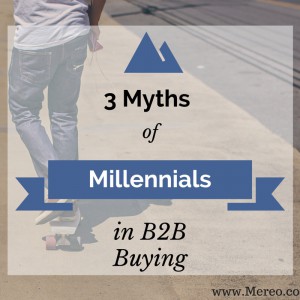If you go back 5-10 years, buying committees were generally 3-5 people: CFO, line of business executive and a stakeholder. Findings from MHI Research Institute’s 2015 Executive Summary proves this is dramatically changing:
“In a typical deal, the number of decision makers is increasing…To continue to be successful, sales professionals must broaden their knowledge base to be able to connect with and influence the variety of people involved. ” (MHI Research Report 5).
There are several reasons for this growth in the “buying team”, but today we are going to take a closer look at some of the new stakeholders participating in these buying committees: millennials.
“46% of b-to-b buyers are now millennials, up from 27% in 2012” (Source: AdAge)
Millennials aren’t just an upcoming generation to be studied and analyzed for how they might impact business practices someday—it is too late for that. They are aging into business and already a part of the B2B buying world. Millennials may be users of the product you represent, in mid-management at a client company or even the head of new company you are prospecting. Therefore, there is a good chance a millennial will be a part of a buying team with which you are engaging.
There is a lot of buzz about this immensely influential demographic, and along with the buzz, comes a lot of false accusations and stereotypes. We wanted to bring you the facts, so we analyzed a recent study by IBM To Buy or Not to Buy: How Millennials are Reshaping B2B Marketing to disprove common myths and to help gain a broader understanding of how to engage with millennial decision makers.
Here are 3 myths we believe this report dispelled, and takeaways for selling to millennial buyers:
Myth #1 Millennials are calling their BFF when researching a business buy.
Although millennials are wildly social when it comes to their consumer decisions (93% bought a product after hearing about it from a friend), they place more stock in vendor relationships with it comes to business (IBM 4).
“This is not about listening to a sales pitch. It’s about having authentic, personalized interactions to explore possibilities and get questions answered. Providing relevant experiences, both virtually and in person, will go a long way with Millennials, who will share their excitement with their coworkers”(IBM 5).
The study goes on to show that when it’s time to make the final purchasing decision, millennials are putting the same amount of stock into research and analytics as they are the opinions of friends and family.
- Takeaway: Although reaching the influencing audience of millennials (friends and family) poses a big challenge for sales teams, it proves the importance of engaging millennials in those first research steps where they are more attainable and influential.
Myth #2 Millennials don’t know how to communicate face-to-face and would rather just correspond via text, IM or through other social media platforms.
Millennials get a bad wrap when it comes to communication. I’m sure you have heard a baby boomer make a comment about “kids these days…always on those cell phones…don’t even know how to talk to each other anymore.” While there is merit to the assumption that millennials are constantly on their phones, this doesn’t necessarily mean this is always how they like to communicate, especially when it comes to business.
69% of millennials said they would prefer a face-to-face meeting when engaging with a vendor during sales research. But, after they gather the information they are looking for, they are more interested in keeping the interactions quick, virtual and on their own terms. When it comes to decision-making time, it seems they want their space and don’t want to be nagged. They will go to the sales rep when they are ready to connect again (IBM 7).
- Takeaway: Be accessible, but don’t be annoying. As myth #1 proved, millennials are definitely interested in real relationships with real vendors, but you need to find ways to be authentic in person and virtually. Take the time to meet with them face-to-face in the beginning, but follow their lead as the sales cycle continues. Make yourself available for questions via IM or text, equip them with the information they need and then don’t be afraid to back off and let them make the next move.
Myth #3 Make a millennial mad, they will make you pay in angry social media rants.
Many people assume that because millennials are the champions of using social media, they are also the champions of abusing it. This can be true, but for many millennials, they have seen the negative impacts, and maybe even been on the wrong side of a damaging social post, and they aren’t interested in joining in on the juvenile use of this powerful platform, at least when it comes to business interactions.
“They will sing a vendor’s praises, but are quite reluctant to post anything negative. Older generations are twice as likely as Millennials to voice their frustrations online.” (IBM 10).
- Takeaway: Make it easy for millennial clients to engage with and access you online. If they have a good experience, they will want to share it with their peers, and making that step as seamless as possible will be of great benefit to you and your organization. Send them a link to your company’s blog, pass on your Twitter, Facebook and LinkedIn handles, but remember not to be cheesy and praise-seeking. Invite them in, but don’t force their hand. Also, consider highlighting them on your blog by writing a success story about them, or use them as a client study. This would be great content for them to in turn share with their social contacts.
